In our opinion, transferable points programs like Chase Ultimate Rewards and Amex Membership Rewards are the most valuable points (or “miles”) to accumulate. These points can often be used to book discounted travel and, even better, can be strategically transferred to airline and hotel programs when valuable awards are available.
In some cases, it’s possible to supercharge your points-earning in these programs by combining the benefits of multiple cards. For example, you can use one card to earn more points at gas stations, another card to earn more at grocery stores and yet another card to get the most value from redeeming those points.
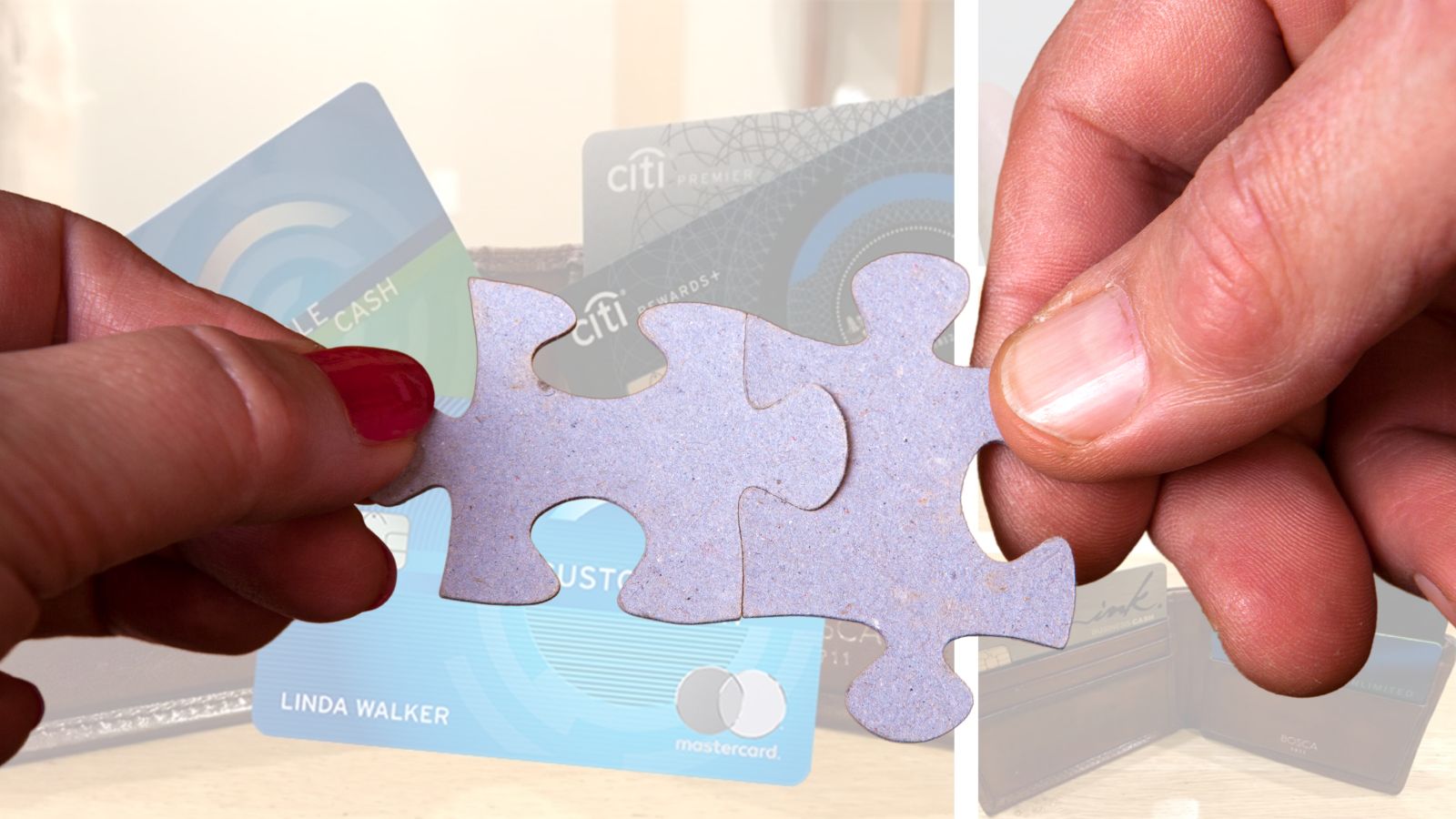
In this post, we’re taking a look at best card combos from American Express, Capital One, Chase, Citi and Wells Fargo. We chose those banks because each offers multiple cards with different earning rates and points that are transferable to airline and hotel programs. That’s important because transferring points in order to book high value awards is the single best way to get outsized value from your rewards.
Listed below are our favorite transferable points combos; credit cards that, like peanut butter and jelly, are better together. With these cards, you can maximize point earnings and get the best value from your points.
Amex Membership Rewards
American Express Gold Card + Blue Business Plus
Total annual fee: $325
- 4X at US supermarkets (Gold – max $25K/year)
- 4X at restaurants (Gold – max $50K/year)
- 3X airfare booked directly with an airline or through amextravel.com (Gold)
- 2X everywhere else (Blue Business Plus – max 50K/year)
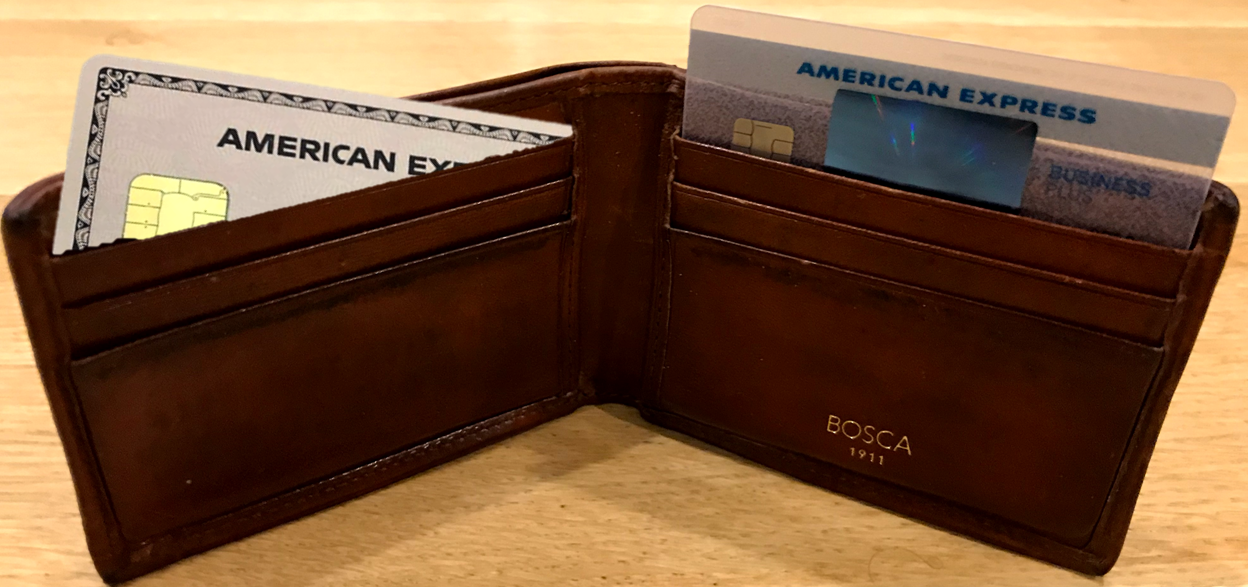
| Card Name w Details & Review (no offer) |
|---|
FM Mini Review: This card offers an awesome return on US supermarket and worldwide dining spend, putting it at or near the top-of-class in both categories. Dining credits and Uber / Uber Eats credits go a long way towards reducing the sting of this card's annual fee. $325 Annual Fee Earning rate: 3X points for flights booked with airlines or on amextravel.com ✦ 4x points at US Supermarkets (up to $25K in purchases, then 1x) ✦ 4x at restaurants worldwide ✦ 1X points on other purchases. Terms apply. (Rates & Fees) Card Info: Amex Pay Over Time Card issued by Amex. This card has no foreign currency conversion fees. Noteworthy perks: Up to $10 in statement credits monthly with participating dining partners (Goldbelly, Wine.com, Five Guys, Seamless/Grubhub, The Cheesecake Factory) ✦ $10 monthly Uber or Uber Eats credit (use it or lose it each month) ✦ $100 hotel credit on qualifying charges on stays of 2 nights or longer, plus a room upgrade upon arrival, if available with The Hotel Collection at americanexpress.com/hc ✦ Enrollment required for select benefits. |
FM Mini Review: 2X rewards for all spend (up to $50K per year) with no annual fee makes this card a winner. Click here for our complete card review No Annual Fee Earning rate: 2X Membership Rewards points on all purchases, up to $50K spend per calendar year (then 1X thereafter). Terms apply. (Rates & Fees) Base: 2X (3.1%) Card Info: Amex Credit Card issued by Amex. This card imposes foreign transaction fees. |
Combo details: Amex automatically pools all of your Membership Rewards points together, even if they were earned with different cards. While you can’t move points from one person to another, you can transfer points to a friend’s airline or hotel program account if they are an authorized user (or employee) on one of your accounts.
Why it’s great: This combination delivers terrific earning potential (2X to 4X everywhere in the US!) and the ability to transfer points to Amex’s valuable transfer Partners. Additionally, Amex offers more transfer bonuses than any other issuer, helping you rack up even more miles. For those who can make good use of the Gold card’s $10/month dining credits and $10/month Uber / Uber Eats credits, the $325 annual fee gets easier to justify.
Shortcomings: Yearly limits and foreign travel. The Gold card’s 4X grocery bonus is capped at $25K annual spend and is limited to stores within the US, while the 4x at restaurants is worldwide, but limited to $50K/year. The Blue Business Plus card charges foreign transaction fees and limits the 2X bonus to $50K per year, making this a less desirable combo for those who spend big or for those looking for great rewards on spending outside of the United States…and since Amex often isn’t accepted outside of the United States, you’ll want a back-up Visa or Mastercard when traveling anyway. This combo also requires a business card to earn 2x everywhere.
Add-on: There are a number of worthwhile cards to consider adding onto this combo:
- The Business Platinum Card offers some fantastic perks, plus the ability to pay for certain flights with points at a value of approximately 1.5 cents each.
- Also worth looking at is the Platinum Card for Schwab which has similar great perks to the Business Platinum and lets you cash out points for 1.1 cents each (1 million points/year max).
- The Amex Green Card is another interesting add-on option. It would add 3X for all travel (not just airfare) and a $100 credit per year for CLEAR.
Capital One “Miles”
Venture X + SavorOne
Total annual fee: $395
- 10X hotels and rental cars booked via Capital One Travel (Venture X)
- 3x dining & entertainment (SavorOne)
- 3x grocery (SavorOne)
- 2X everywhere else (Venture X)
- Perks include lounge access, $300 annual travel rebate, 10,000 point anniversary bonus, no foreign transaction fees.
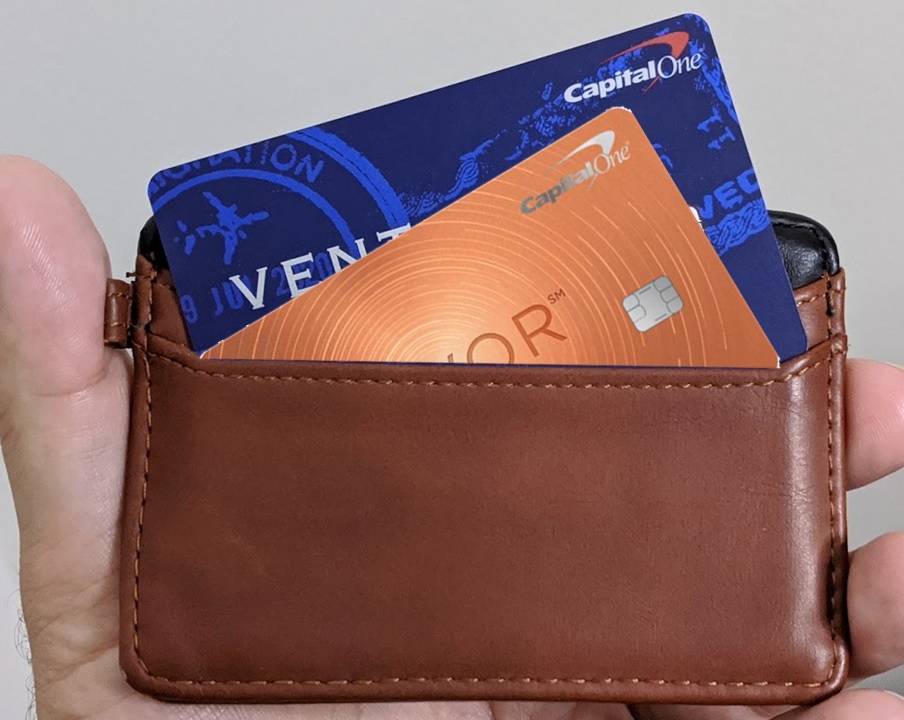
| Card Name w Details & Review (no offer) |
|---|
FM Mini Review: This card offers annual rebates that easily mitigate the fee for those who travel often. Authorized users are free and also get access to perks like Priority Pass, Capital One Lounges, Plaza Premium lounges, and more. The card earns 2 "miles" per dollar on most purchases just like the Capital One Venture Rewards card, which are worth exactly 1 cent each toward travel. This makes the return on most spend similar to a 2% cash back card (though in this case you must redeem your miles to offset travel in order to get 1 cent per mile). One huge advantage over cash back: Capital One allows transfering their "miles" to airline miles & hotel points. Click here for our complete card review $395 Annual Fee Earning rate: 10X miles on hotels and rental cars booked via Capital One Travel ✦ 5x miles on flights and vacation rentals booked via Capital One travel. ✦ 2X miles everywhere else. Card Info: Visa Infinite issued by CapOne. This card has no foreign currency conversion fees. Noteworthy perks: $300 annual credit for bookings made through Capital One Travel ✦ 10,000 bonus miles each year starting at first anniversary ✦ Up to $120 application fee credit for Global Entry or TSA PreCheck® ✦ Capital One Lounge access ✦ Priority Pass membership w/ unlimited guests (lounges only) ✦ Plaza Premium lounge access ✦ Cell phone insurance ✦ Trip insurance ✦ Primary CDW coverage ✦ Redeem miles for travel at value of 1 cent per mile ✦ Convert "miles" to airline miles & hotel points |
No Annual Fee Earning rate: 3% on dining, entertainment, select streaming services, and purchases at grocery stores (excluding superstores like Walmart® and Target®) ✦ 8% cash back on Capital One Entertainment purchases ✦ 5% on hotels and rental cars booked via Capital One Travel (terms apply) ✦ 1% everywhere else Base: 1% Dine: 3% Grocery: 3% Other: 3% Card Info: Mastercard issued by CapOne. This card has no foreign currency conversion fees. Noteworthy perks: No foreign transaction fees |
Combo details: Even though the Venture X has a $395 annual fee, you could consider this combo to be “almost free” after rebates. The Venture X offers $300 in annual travel rebates plus 10K points each card anniversary which combined more than make up for the annual fee. The fee-free SavorOne adds 3x grocery, dining, and entertainment to the already strong 2x everywhere earnings offered by Venture X. Capital One lets you move cash back to a “Miles” card so that the rewards then become transferable to partners. This allows you to earn 3% cash back with the SavorOne card and then convert that to “miles” by moving it to the Venture X card, unlocking better value by transferring to partners for high value awards. You can also freely move points to anyone, so you don’t need more than one Venture X card in the family to make this combo work.
Why it’s great: Very good earnings with a “free after rebate” annual fee. This is the only combo that offers the same great earnings internationally with no foreign transaction fees. The Venture X adds great features like cell phone protection, airport lounge access, and more.
Shortcomings: The only way to get better than 1 cent per “Mile” value is by transferring to airline and hotel partners. Much less opportunity for multiple, blingy welcome offers than Chase or Amex. T
Variations:
- Swap Venture X for Venture Rewards: Lower the annual fee to $95 per year with the Venture Rewards card instead of Venture X. Both offer 2x everywhere earnings, no foreign transaction fees, and the ability to transfer to airline and hotel partners. However, the Venture Rewards card does not offer annual rebates that make up for the annual fee.
- Make it fee free: You can cobble together a decent combo with no annual fees (and still have no foreign transaction fees). Start with the SavorOne for 3x grocery, dining, and entertainment and then add the fee-free Quicksilver card to get 1.5x everywhere else and then move all that cash back to the fee-free VentureOne Rewards card in order to transfer “Miles” to airline and hotel partners.
Chase Ultimate Rewards
Sapphire Reserve + Ink Business Cash + Freedom Unlimited
Total annual fee: $550
- 10x hotels & car rentals booked through Chase (Sapphire Reserve)
- 5x airfare booked through Chase (Sapphire Reserve)
- 5X phone, internet, cable, office supplies (Ink Cash – $25K/year max)
- 3X travel & dining (Sapphire Reserve)
- 3x drug store (Freedom Unlimited)
- 2X gas stations (Ink Cash)
- 1.5x (Freedom Unlimited)
- Perks include lounge access, $300 annual travel rebate, no foreign transaction fees, primary rental car insurance.
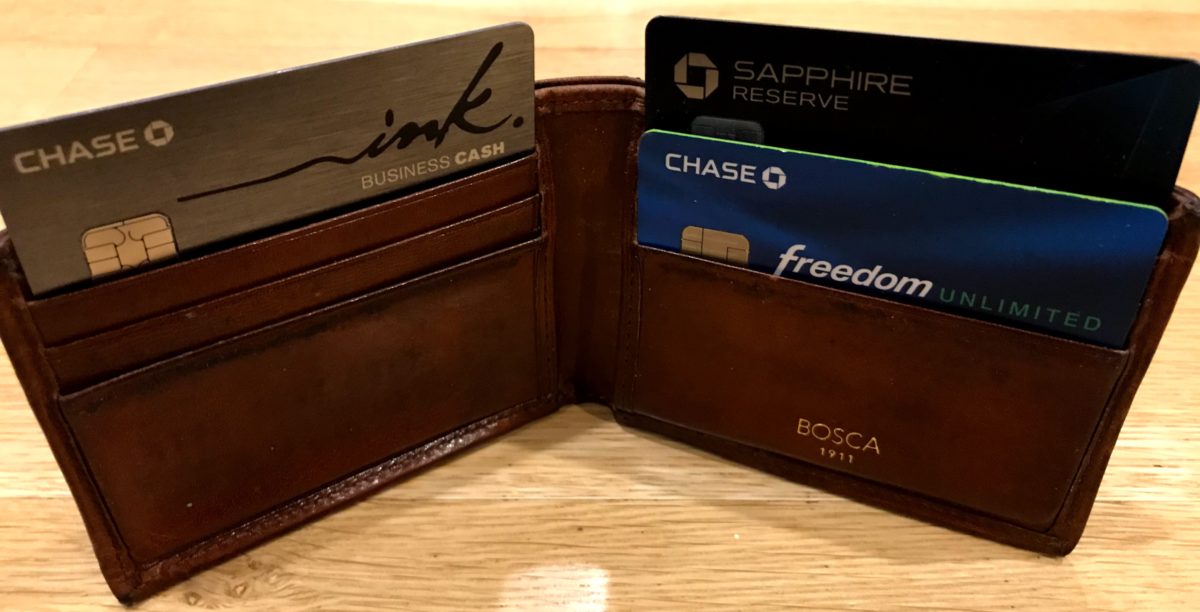
| Card Name w Details & Review (no offer) |
|---|
FM Mini Review: Excellent all-around card for frequent traveler. Best when paired with no-fee Chase Freedom Flex, no-fee Freedom Unlimited & no-fee Chase Ink Cash Click here for our complete card review $550 Annual Fee Earning rate: 10X hotels & car rentals booked through Chase Travel℠ ✦ 10X Chase Dining ✦ 5X flights booked through Chase ✦ 3X Travel and Dining ✦ 10X Lyft (through March 2025) Card Info: Visa Infinite issued by Chase. This card has no foreign currency conversion fees. Noteworthy perks: $300 Annual Travel Credit ✦ Points worth 1.5 cents each towards travel when booked through the Chase Travel(SM) Portal✦ Transfer points to airline & hotel partners ✦ Primary auto rental collision damage waiver ✦ Priority Pass Select lounge access ✦ Access Sapphire Lounges for yourself and 2 guests for free ✦ Access select Air Canada Maple Leaf lounges when flying Star Alliance ✦ Up to $100 Global Entry fee credit ✦ Free DashPass through 2027 ✦ Earn 10X on Lyft spend✦ Free Lyft Pink All Access Memberhsip through December 2024 See also: Chase Ultimate Rewards Complete Guide |
FM Mini Review: Great for 3x categories and 1.5X everywhere else. Excellent companion card to Sapphire Reserve, Sapphire Preferred, or Ink Business Preferred. Click here for our complete card review No Annual Fee Earning rate: 5x travel booked through Chase Travel℠ ✦ 5X Lyft through March 2025 ✦ 3x dining ✦ 3x drugstores ✦ 1.5X everywhere else Card Info: Visa Signature or Platinum issued by Chase. This card imposes foreign transaction fees. Noteworthy perks: Free DashPass for up to 3 months upon activation ✦ $10 monthly credit for non-restaurant DoorDash orders See also: Chase Ultimate Rewards Complete Guide |
FM Mini Review: This one should be in everyone's wallet. Incredible welcome bonus for a no-annual-fee card. Great card for 5X categories. Excellent companion card to Sapphire Reserve, Sapphire Preferred, or Ink Business Preferred. Click here for our complete card review No Annual Fee Earning rate: 5X office supplies and cellular/landline/cable (on up to $25,000 in total purchases in 5x categories annually) ✦ 2X on the first $25K in combined purchases at gas stations and restaurants each cardmember year ✦ 5X Lyft through March 2025 Card Info: Visa Signature Business issued by Chase. This card imposes foreign transaction fees. See also: Chase Ultimate Rewards Complete Guide |
Combo details: Many of Chase’s no annual-fee cards are advertised as cashback cards, but they actually earn Ultimate Rewards points. Once you have points in one of these accounts, you can move them to your Sapphire Reserve account in order to make them transferable. Chase even lets you move points to another person in the same household, so it makes sense for a couple to earn points across a variety of Ultimate Rewards card and then move all of those points to a single Sapphire Reserve account. The Sapphire Reserve card provides three ways to get great value from your points: 1) transfer to airline and hotel partners for high value awards; 2) Book travel through Chase at a value of 1.5 cents per points; and 3) Erase statement charges at 1.5 cents per point value against current Pay Yourself Back categories (see this post for details).
Why it’s great: Ultimate Rewards is the only points ecosystem listed here that offers 1:1 transfers to Hyatt, which can translate into incredible value. Points are also worth 1.5 cents each towards booking travel via Chase, so if you’re using them that way, you’ll essentially earn 2.25 cents in travel per dollar spent with the Freedom Unlimited card’s 1.5x everywhere, 4.5 cents in travel per dollar spent at drug stores and for dining, 4.5 cents in travel per dollar spent on travel & dining with your Sapphire Reserve card and 7.5 cents in travel per dollar on phone, internet, cable, and office supplies with your Ink Business Cash card. Note that, while 1.5 cents per point is good, you can often get even better value by transferring points to Chase’s high value travel partners. The Sapphire Reserve offers excellent automatic travel protections…provided that you don’t live in New York.
Shortcomings: The Sapphire Reserve card is expensive: at $550 per year, the $300 annual travel rebate only goes a bit over half way towards rebating the card’s fee. The Freedom Unlimited and Ink Business Cash cards charge foreign exchange fees, so you’ll want to use your Sapphire Reserve card when traveling outside of the US. This is also the only program in this round-up that doesn’t offer a standard category bonus at grocery stores so, if you spend a lot at grocery stores, you may do better with Amex, Capital One, or Citi.
Add-on: Consider adding the no-fee Chase Freedom Flex card which offers rotating 5X categories.
Variation: You can lower annual fees down to $95 per year total by replacing the Sapphire Reserve with either the Sapphire Preferred or Ink Business Preferred. Both offer the ability to transfer points to travel hotel and airline partners. With these cards, though, you’ll only get 1.25 cents per point value when paying for travel through Chase. Also, while they still have good travel protections, Sapphire Reserve is the best.
Special note: Since the Chase Sapphire Preferred card often has a better welcome bonus than the Sapphire Reserve, it can make sense to sign up for the Preferred and upgrade to the Reserve card after a year.
Citi ThankYou Rewards
Total annual fee: $95
Strata Premier + Double Cash + Custom Cash + Rewards+
- 5X monthly on $500 spend (Custom Cash)
- 3X grocery, dining, gas stations, flights, hotels, and travel agencies (Strata Premier)
- 2X everywhere else (Double Cash)
- 10% rewards rebate on up to 100,000 points/year (Rewards+)

| Card Name w Details & Review (no offer) |
|---|
FM Mini Review: Very strong earnings for spend. Excellent bonus categories. Points transferable to select airlines. Recommend pairing this card with Citi Double Cash and Citi Rewards+. Click here for our complete card review $95 Annual Fee Earning rate: 3X grocery ✦ 3X dining ✦ 3X gas stations & EV charging ✦ 3X flights, hotels, travel agencies ✦ 10X hotels, car rentals, and attractions booked through Citi Travel℠ Card Info: Mastercard World Elite issued by Citi. This card has no foreign currency conversion fees. Noteworthy perks: Transfer points to airline partners ✦ $100 Annual Hotel Savings Benefit ($100 off a $500+ hotel stay, excluding taxes and fees, when booked through Citi Travel) ✦ Travel protections See also: Citi ThankYou Rewards Complete Guide |
FM Mini Review: The fact that you can get 10% Points Back when you redeem, up to the first 100,000 points redeemed per year, makes this a great choice to pool with ThankYou Premier, Prestige, and/or Double Cash Click here for our complete card review No Annual Fee Earning rate: 5x on travel booked through Citi Travel℠ Portal through December 31, 2025 (excludes air travel) ✦ 2X at supermarkets and gas stations on up to $6,000 per year ✦ Round up to nearest 10 TY points on all purchases Card Info: Mastercard World issued by Citi. This card imposes foreign transaction fees. Noteworthy perks: Round up to the nearest 10 points on all purchases with no cap. ✦ Get 10% Points Back when you redeem, up to the first 100,000 points redeemed per year. See also: Citi ThankYou Rewards Complete Guide |
FM Mini Review: 2X rewards for all spend with no annual fee makes this card a winner. Earn 2X everywhere and redeem for the equivalent of 2% cash back or 2X ThankYou points. Pair with the Premier or Prestige card to make points transferrable to airlines. Click here for our complete card review No Annual Fee Earning rate: 2% cash back everywhere (1% cash back for each purchase + 1% when paying your credit card bill for that purchase). ✦ For a limited time: Earn 5% total cash back on hotel, car rentals, and attractions booked on Citi TravelSM Portal through 12/31/24. Base: 2X (2.9%) Card Info: Mastercard World Elite issued by Citi. This card imposes foreign transaction fees. Noteworthy perks: 1X when you make a purchase + 1X when you pay for those purchases See also: Citi ThankYou Rewards Complete Guide |
FM Mini Review: This is a great card to have and hold for a single category where you spend no more than $500 per month as it represents an excellent return without rotating categories to track. No Annual Fee Earning rate: 5x on purchases in your top eligible spend category each billing cycle, up to the first $500 spent, 1x thereafter. Eligible categories: Restaurants, Gas Stations, Grocery Stores, Select Travel, Select Transit, Select Streaming Services, Drugstores, Home Improvement Stores, Fitness Clubs and Live Entertainment. ✦ 1x on all other purchases Base: 1X (1.45%) Travel: 5X (7.25%) Dine: 5X (7.25%) Gas: 5X (7.25%) Grocery: 5X (7.25%) Other: 5X (7.25%) Card Info: Mastercard issued by Citi. This card imposes foreign transaction fees. See also: Citi ThankYou Rewards Complete Guide |
Combo details: Citi lets you pool ThankYou points together so that you can get the best possible value for your points. You can also transfer points to anyone, but when you do that, those points must then be used within 90 days or else they’ll expire.
Why it’s great: Excellent point earnings, especially for a combo with a total $95 annual fee (the Strata Premier card costs $95 per year while the other cards are free). Everything listed here also provides free authorized user cards. Add in a 10% rewards rebate off of up to 100K points per year and the $95 fee for this combo becomes a no-brainer. You can also earn great rewards for tiny purchases with the Rewards+ card while the Custom Cash card adds a “customizable” 5x category to your wallet. Travel partners are a nice mix of airline and hotels, some unique to Citi.
Shortcomings: Other than the Rewards+ 10% rebate, Citi has discontinued options for getting better than 1 cent per point value other than transferring points to partners. Plus, Citi has somewhat lackluster travel protections when comparted to some of the other card combinations listed here.
Wells Fargo Rewards
Autograph Journey + Attune + Active Cash
Total annual fee: $95
- 5X hotels (Autograph Journey)
- 4X airlines (Autograph Journey)
- 4X self-care (gym memberships, spas, massage parlors, barber shops, salons), sports, recreation, entertainment, EV charging stations, public transportation and second-hand stores (Attune)
- 3X restaurants & other travel (Autograph Journey)
- 2X everywhere else (Active Cash)
- Perks include a $50 annual credit towards airfare.
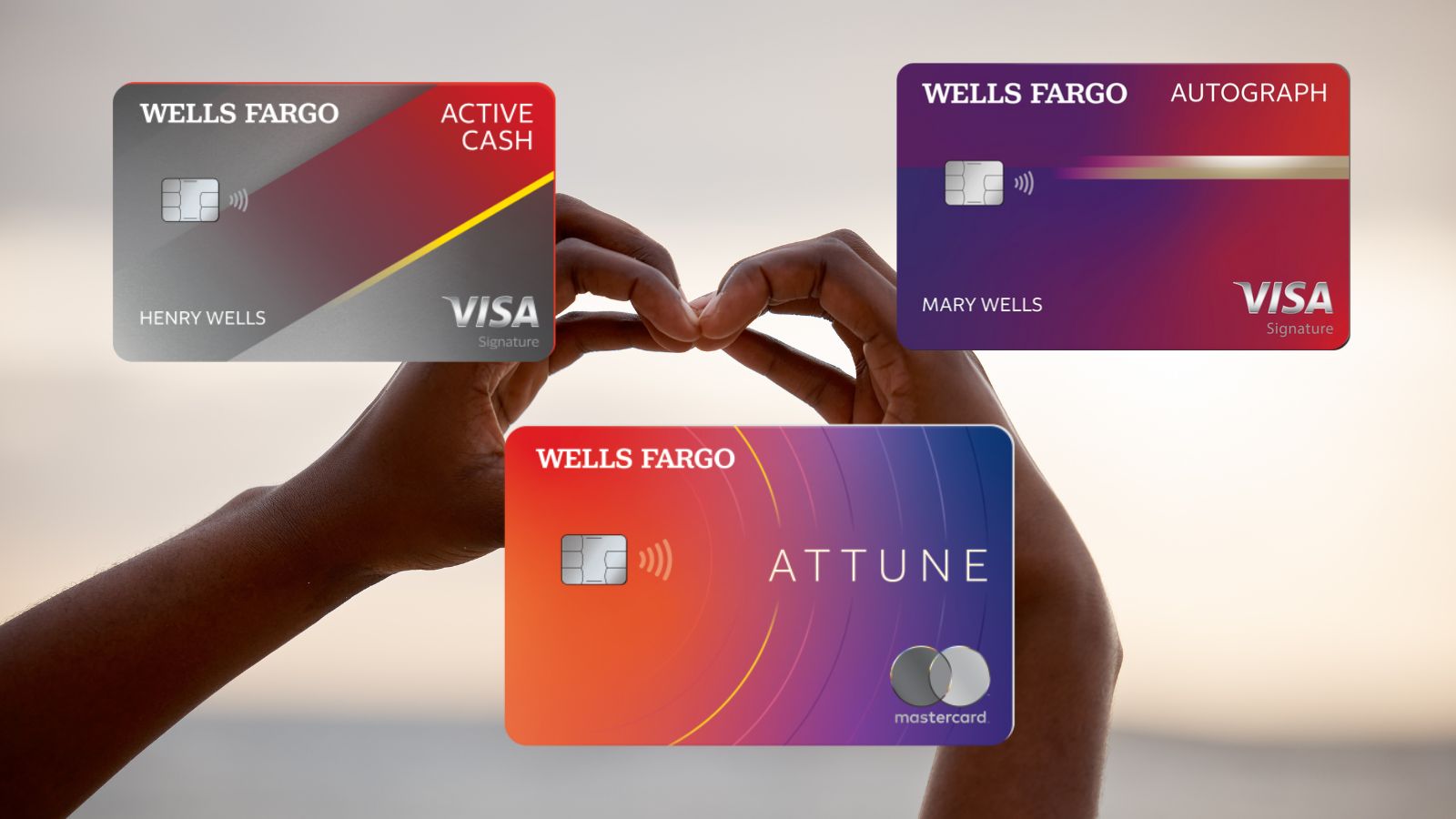
| Card Name w Details & Review (no offer) |
|---|
FM Mini Review: This could be a good fit for those who spend a lot in the card's 4X categories. No Annual Fee Earning rate: 4X self-care (gym memberships, at spas / massage parlors, and barber shops / salons) ✦ 4X sports, recreation, and entertainment ✦ 4X "planet-friendly purchases" like EV charging stations, riding public transportation, and purchasing select second hand and vintage ✦ 1X everywhere else Card Info: Mastercard World Elite issued by Wells. This card imposes foreign transaction fees. Noteworthy perks: Cellular Telephone Protection |
$95 Annual Fee Earning rate: 5X hotels ✦ 4X airlines ✦ 3X restaurants & other travel ✦ 1X everywhere else Card Info: Visa Signature issued by Wells. This card has no foreign currency conversion fees. Noteworthy perks: $50 annual statement credit with $50 minimum airline purchase ✦ Trip cancellation / interruption protection ✦ Cell phone protection ($25 deductible, $1000 max per claim) ✦ Transfer points to select airline & hotel programs |
FM Mini Review: This card offers a competitive flat 2% back on purchases and includes good cell phone insurance for a fee-free card (up to $600 in protection with just a $25 deductible). No Annual Fee Base: 2X (2%) Card Info: Visa issued by Wells. This card imposes foreign transaction fees. |
Combo details: Like Capital One, Wells Fargo lets you transfer cash rewards to the Autograph Journey card at rate of 1 cent:1 point. This allows you to use rewards earned on all three cards towards transfers to travel partners.
Why it’s great: These cards offer excellent points earnings for a combo with a total $95 annual fee, not including the $50 annual airfare credit that comes with the Autograph Journey. The 4x category on the Attune card is ridiculously broad…almost like an everywhere else category. This will allow for 4x earnings at a lot of places that you normally would be getting a base 2x with other combos. 5x at hotels is another unique feature of this combo. The cards offer decent travel and purchase protections, as well as very good cell phone insurance.
Shortcomings: The biggest downside is that this combo has no grocery bonus, so the best that you can do is 2x with the Active Cash. While the Autograph Journey doesn’t have foreign transaction fees, the other two cards do, making it a one-card system when traveling. Wells Fargo’s collection of transfer partners is undoubtedly the weakest of all the programs we’re comparing. Currently, there’s only seven total, including three different Avios programs that effectively function as one. There’s no domestic airline involved and the only hotel partner is Choice Privileges (which does get an excellent 1:2 transfer ratio). If Wells Fargo can beef up its partner list to rival the other issuers listed here, this will become a much more delectable combo.
Which is the best credit card combo?
So, which combo is best? It’s difficult to answer that question without understanding the needs of the person that’s asking. Any one of these combos may be best for you depending upon your tolerance for annual fees, your spend patterns, and how you’re likely to use your rewards. That said, we have opinions.
Greg
By a hair, I think that the Capital One Venture X + SavorOne combo is best. I love this combo because it only requires holding 2 cards and it offers strong rewards in popular categories (3x grocery, dining, and entertainment); strong rewards on all other spend (2x); no foreign transaction fees; and ultra-premium card features (airport lounge access) all for “free after rebate” (spend $395, but get back $300 in travel credits and 10K points each year).
That said, I could easily and convincingly argue that any one of the other combos is best. It probably just depends on what mood I’m in when I’m choosing. If I’m feeling particularly excited by Hyatt awards, I’ll pick the Chase combo (since they’re the only one in this roundup that offers transfers to Hyatt). If I’m dreaming about all of the great ways to earn and burn Amex Membership Rewards points, I’ll pick the Amex combo. And if I want a single cheap combo ($95 total) that offers great point earning options along with 10% back on awards (thanks to Rewards+), I’ll pick Citi.
Tim
It’s very, very close for me as well. Greg could talk me into either the Chase or Capital combos, but I’d probably take Citi 4-card jamboree. Although it technically involves four cards, it’s really one two in day-to-day use: the Strata Premier and the Double Cash. The Rewards+ is really a sock drawer card with a 10% points rebate and the Custom Cash can just be a category-specific card; take it the grocery store (or any other category) for $500 a month and then forget about it.
I love this combo because it offers probably the best all-around card listed here for category bonuses: the Strata Premier which earns 3x at gas stations, grocery stores, restaurants AND travel – all on one card. I can give player 2 (my wife) a Double Cash and the Strata Premier and know that she’s earning 2x everywhere and 3x at most of the places that she spends money.
I’m also a big fan of Citi’s mix of transfer partners, especially EVA Air and the lodging combination of Leading Hotels of the World, Wyndham and Choice 1:2 transfers. It’s not perfect, but there’s a lot of fun options there.
Final Thoughts
We should point out that it’s not necessary to pick a single bank’s combo.. both of us have a combination of cards that earn Amex, Chase, and Citi points. Greg would have Capital One “Miles” too if they hadn’t mysteriously shut down his account. If you go for multiple combos, though, its worth paying close attention to annual fees, which can add up quickly if you try to get (and keep) the best cards from each program.





All these articles about accumulating point to use for travel expenses seem to be intent on getting folks to sign up for multiple cards (some with high annual costs). I see little benefit except with airline labeled credit cards with large bonus miles, and then only until that initial bonus has been earned. I have a free credit card that rebates 2%, and another that rebates 5%. I never worry about how airlines and hotels continue to devalue their points, I have cash instead.
I am not full blown in the Citi camp but have to admit that Citi has been growing on me recently. Even though I find the Strata Premier hotel credit to be almost worthless the power of those four cards for $95 is pretty impressive. And even limiting to Strata Premier for foreign travel that one card has a lot of categories by itself. The downside is that I find Citi IT systems to be really bad. In particular their fraud prevention systems don’t give an easy way to authenticate on the spot–really fun when you are at the checkout buying groceries and it takes 15 minutes to get the fraud prevention authentication message.
Also I have been leaning into Citi more recently for no other reason than as a backup to other banks should I decide to drop high annual fee cards. Like the Amex Gold coupon book works out for me now, but I feel like I’m always one change away from it being a net negative that would prompt me to drop it. Venture X is solid now, but I keep thinking it is too good to be true and there will be fee increase at some point.
For what it is worth, I find Strata Premier + Venture X to be a dynamite mixed combo for foreign travel.
I know this will vary from person to person but a big strike against Capital one for me is they dont seem to approve people for 2nd cards if you have a lot of applications (or unused credit) . Havent had any issue with chase, citi, Amex, but seem to be stuck with just a ventureX
[…] conventional wisdom from my friends Greg and Nick at Frequent Miler is to take your card to your local grocery store once a month and buy a $500 grocery store gift […]
The only reason why I don’t choose Citi as the best combo (quadfecta) is due because the FTF in the double cash. I normally spend in Foreign Currency so that’s a big No for me.
The Capital One duo is easy , and No Foreign Transaction Fees.
Looking to cancel AMEX Platinum when the annual fee hits next month. Had it for a year. What is the best strategy for about 200k points ? Have Blue AMEX card but I don’t think it allows to transfer points. No plan to travel internationally next year so airline partner transfer is out of question.
blue business plus? it absolutely allows transfers.
Blue personal card.
I don’t know what card you’re talking about. Blue Cash? If it’s that’s what you have, it won’t work. You need to open an MR earning card before you cancel the platinum.
Blue Business Plus is a good option
I’m with TIM
It may not be a “standard” grocery category, but the Chase Sapphire Preferred has that 3x “online” grocery, which works well for folks who do a bunch of online grocery shopping, but can also easily be gamed at many larger supermarkets when paying in person through their apps. Not as straightforward as some of the other grocery bonus category offerings, but can work with some not too difficult work-arounds
Yes! It gives me 3x when using the grocery store app to do curbside pickup. The groceries cost the same as if I went into the store, there’s no charge for pickup, and I save time. Win win win!
Don’t overlook the cheaper Chase Sapphire Preferred in the Chase combination group. Same price as the Citi Strata but with a $50 hotel credit that’s a lot easier to use for full value than the Citi $100 off $500 credit.
What would be the best combination allowing multiple reward programs? Most of us are acquiring points in multiple rewards currencies so there’s no need to restrict this to a single program.
I think Bilt should be part of this strategy. While it is a one card option, it has the best transfer partners with the best bonuses. The Alaska transfer was outstanding.
I’m at a crossroads with Chase. Maybe someone here has faced similar.
I’m not going to be able to open any new Chase cards (and I really want a Sapphire)…because I already have too many open and unused….I’ve been putting everything on my Freedom Flex for now, thousands of spend, but it doesn’t seem to matter.
I am wondering if it might be helpful before future applications, to just call now and cancel some of the cards, mostly ones more recently opened, to protect the credit rating?
In their recent denial, they claimed I have too much available credit with them.
So that seems like it might make sense?
Thanks.
“mostly ones more recently opened”…this depends on the meaning of “recently”. DO NOT cancel a card if you’ve had it for less than one year.
Since they say “too much available credit”, do you reduce your credit limit on cards you rarely/never use? Once finished with sign-up bonus spend, I always reduce the CL to around $2000.
yes, I know not to cancel < 12 months….I have never reduced my CL….that makes sense. I will do that today. Thanks.
When you apply for new card you should call after the application goes to pending status and tell them you want to move credit from another card. That way they are not extending you new credit, but you have the same credit just more cards. They have been accommodating to me in the past with this, so hopefully it works for you.
Looks like a small typo on the Chase trifecta details – there shouldn’t be a 10,000 annual point bonus there, right?
Right. Thanks. Fixed.
I have all 3 Chase cards. Can someone enlighten me on the “10,000 point anniversary bonus” mentioned? Am I missing something? Thanks
That was a mistake. Fixed.
I’ll add one more to the Citi list… Citi At&t access more for 3x online shopping. Obviously it isn’t available anymore but having that card plus the other 4 mentioned is a powerful combo.